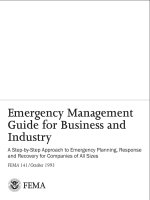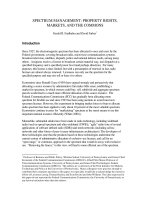International FInance management 2nd Robert Hodrick and Geert Bekaert
Bạn đang xem bản rút gọn của tài liệu. Xem và tải ngay bản đầy đủ của tài liệu tại đây (7.6 MB, 821 trang )
The Prentice Hall Series in Finance
Adelman , Marks
Entrepreneurial Finance
Gitman , Zutter
Principles of Managerial Finance*
McDonald
Fundamentals of Derivatives Markets
Andersen
Global Derivatives: A Strategic Risk
Management Perspective
Gitman , Zutter
Principles of Managerial Finance––Brief
Edition*
Mishkin , Eakins
Financial Markets and Institutions
Bekaert , Hodrick
International Financial Management
Goldsmith
Consumer Economics: Issues and Behaviors
Berk , DeMarzo
Corporate Finance*
Haugen
The Inefficient Stock Market: What Pays Off
and Why
Berk , DeMarzo
Corporate Finance: The Core*
Berk , DeMarzo , Harford
Fundamentals of Corporate Finance*
Boakes
Reading and Understanding the Financial
Times
Brooks
Financial Management: Core Concepts*
Copeland , Weston , Shastri
Financial Theory and Corporate Policy
Dorfman , Cather
Introduction to Risk Management and
Insurance
Eiteman , Stonehill , Moffett
Multinational Business Finance
Fabozzi
Bond Markets: Analysis and Strategies
Fabozzi , Modigliani
Capital Markets: Institutions and
Instruments
Haugen
The New Finance: Overreaction, Complexity,
and Uniqueness
Holden
Excel Modeling in Corporate Finance
Holden
Excel Modeling in Investments
Hughes , MacDonald
International Banking: Text and Cases
Hull
Fundamentals of Futures and Options
Markets
Hull
Options, Futures, and Other Derivatives
Hull
Risk Management and Financial Institutions
Keown
Personal Finance: Turning Money into Wealth*
Keown , Martin , Petty
Foundations of Finance: The Logic and
Practice of Financial Management*
Moffett , Stonehill , Eiteman
Fundamentals of Multinational Finance
Nofsinger
Psychology of Investing
Ormiston , Fraser
Understanding Financial Statements
Pennacchi
Theory of Asset Pricing
Rejda
Principles of Risk Management and
Insurance
Seiler
Performing Financial Studies: A
Methodological Cookbook
Shapiro
Capital Budgeting and Investment
Analysis
Sharpe , Alexander , Bailey
Investments
Solnik , McLeavey
Global Investments
Stretcher , Michael
Cases in Financial Management
Titman , Keown , Martin
Financial Management: Principles and
Applications*
Kim , Nofsinger
Corporate Governance
Titman , Martin
Valuation: The Art and Science of Corporate
Investment Decisions
Madura
Personal Finance*
Van Horne
Financial Management and Policy
Frasca
Personal Finance
Marthinsen
Risk Takers: Uses and Abuses of Financial
Derivatives
Van Horne , Wachowicz
Fundamentals of Financial Management
Gitman , Joehnk , Smart
Fundamentals of Investing*
McDonald
Derivatives Markets
Fabozzi , Modigliani , Jones , Ferri
Foundations of Financial Markets and
Institutions
Finkler
Financial Management for Public, Health,
and Not-for-Profit Organizations
*denotes
titles
Weston , Mitchel , Mulherin
Takeovers, Restructuring, and Corporate
Governance
Log onto www.myfinancelab.com to learn more
International Financial Management
Editorial Director: Sally Yagan
Editor-in-Chief: Donna Battista
Acquisitions Editor: Tessa O’Brien
Editorial Project Manager: Amy Foley
Editorial Assistant: Elissa Senra-Sargent
Director of Marketing: Patrice Jones
Marketing Assistant: Ian Gold
Senior Managing Editor: Nancy H. Fenton
Senior Production Project Manager: Meredith Gertz
Permissions Project Supervisor: Michael Joyce
Permissions Editor: Maria Leon Maimone
Art Director: Jayne Conte
Cover Designer: Suzanne Behnke
Cover Photo: Kentoh>Shutterstock
Senior Manufacturing Buyer: Carol Melville
Media Producer: Nicole Sackin
Production Coordination, Composition, and Art Creation: PreMediaGlobal
Credits and acknowledgments borrowed from other sources and reproduced, with permission,
in this textbook appear on appropriate page within the text.
Many of the designations by manufacturers and seller to distinguish their products are
claimed as trademarks. Where those designations appear in this book, and the publisher was
aware of a trademark claim, the designations have been printed in initial caps or all caps.
Copyright © 2012, 2009 by Pearson Education, Inc., publishing as Prentice Hall. All
rights reserved. Manufactured in the United States of America. This publication is protected
by Copyright, and permission should be obtained from the publisher prior to any prohibited
reproduction, storage in a retrieval system, or transmission in any form or by any means,
electronic, mechanical, photocopying, recording, or likewise. To obtain permission(s) to
use material from this work, please submit a written request to Pearson Education, Inc.,
Permissions Department, One Lake Street, Upper Saddle River, New Jersey 07458, or you
may fax your request to 201-236-3290.
Library of Congress Cataloging-in-Publication Data
Bekaert, Geert.
International financial management / Geert Bekaert, Robert J. Hodrick.—2nd ed.
p. cm.
ISBN-13: 978-0-13-216276-0
ISBN-10: 0-13-216276-8
1. International finance. 2. International business enterprises—Finance. 3. Foreign
exchange. I. Hodrick, Robert J. II. Title.
HG3881.B436 2012
658.15’99—dc23
2011023449
10 9 8 7 6 5 4 3 2 1
ISBN-13: 978-0-13-216276-0
ISBN-10: 0-13-216276-8
International Financial
Management
Geert Bekaert
Columbia University and the National Bureau of Economic Research
Robert Hodrick
Columbia University and the National Bureau of Economic Research
Boston Columbus Indianapolis New York San Francisco Upper Saddle River
Amsterdam Cape Town Dubai London Madrid Milan Munich Paris Montréal Toronto
Delhi Mexico City São Paulo Sydney Hong Kong Seoul Singapore Taipei Tokyo
This page intentionally left blank
To my world of women, Emma, Britt, Laura and Ann
— Geert
To my wife, Laurie, and my children, Reid and Courtney,
with love — Bob
This page intentionally left blank
BRIEF CONTENTS
PART I
Chapter 1
Chapter 2
Chapter 3
Chapter 4
Chapter 5
PART II
Chapter 6
Chapter 7
Chapter 8
Chapter 9
Chapter 10
PART III
Chapter 11
Chapter 12
Chapter 13
Chapter 14
PART IV
Chapter 15
Chapter 16
Chapter 17
Chapter 18
Chapter 19
PART V
INTRODUCTION TO FOREIGN EXCHANGE MARKETS
AND RISKS
1
Globalization and the Multinational Corporation
The Foreign Exchange Market
36
Forward Markets and Transaction Exchange Risk
The Balance of Payments
101
Exchange Rate Systems
133
1
69
INTERNATIONAL PARITY CONDITIONS AND
EXCHANGE RATE DETERMINATION
173
Interest Rate Parity
173
Speculation and Risk in the Foreign Exchange Market
205
Purchasing Power Parity and Real Exchange Rates
246
Measuring and Managing Real Exchange Risk
281
Exchange Rate Determination and Forecasting
315
INTERNATIONAL CAPITAL MARKETS
International Debt Financing
354
International Equity Financing
398
International Capital Market Equilibrium
Country and Political Risk
475
354
428
INTERNATIONAL CORPORATE FINANCE
International Capital Budgeting
521
Additional Topics in International Capital Budgeting
553
Risk Management and the Foreign Currency Hedging Decision
Financing International Trade
616
Managing Net Working Capital
642
FOREIGN CURRENCY DERIVATIVES
521
589
671
Chapter 20 Foreign Currency Futures and Options
671
Chapter 21 Interest Rate and Foreign Currency Swaps
723
vii
This page intentionally left blank
CONTENTS
Preface
xxiii
About the Authors
PART I
xxix
INTRODUCTION TO FOREIGN EXCHANGE MARKETS
AND RISKS
1
CHAPTER 1 Globalization and the Multinational Corporation
1
1.1 Introduction
1
1.2 Globalization and the Growth of International Trade and Capital Flows
The Growth of International Trade
2
The Globalization of Financial Markets
1.3
Multinational Corporations
5
9
How Multinational Corporations Enter Foreign Markets
The Goals of an MNC
11
Corporate Governance Around the World
12
Multinational Corporations and Foreign Direct Investment
1.4
Other Important International Players
International Banks
18
International Institutions
18
Governments
21
Individual and Institutional Investors
1.5
9
16
18
22
Globalization and the Multinational Firm: Benefactor or Menace?
A Rocky Road to Free Trade
23
Do International Capital Flows Cause Havoc?
The Anti-Globalist Movement and MNCs
26
Some Final Thoughts on Globalization
28
1.6
Overview of the Book
2
23
25
28
Part I: Introduction to Foreign Exchange Markets and Risks
29
Part II: International Parity Conditions and Exchange Rate Determination
Part III: International Capital Markets
29
Part IV: International Corporate Finance
30
Part V: Foreign Currency Derivatives
30
A Final Introduction
30
29
1.7 Summary
32
Questions
33
Problems
33
Bibliography
34
CHAPTER 2 The Foreign Exchange Market
36
2.1 The Organization of the Foreign Exchange Market
Size of the Market
38
Types of Contracts Traded
36
39
ix
Foreign Exchange Dealers
39
Foreign Exchange Brokers
39
Other Participants in the Forex Market
40
Electronic Foreign Exchange Trading (eFX)
The Competitive Marketplace
42
2.2
Currency Quotes and Prices
43
Exchange Rates
44
Exchange Rate Quotes
44
Vehicle Currencies and Currency Cross-Rates
Triangular Arbitrage
49
2.3
53
Inside the Interbank Market II: Communications and
Fund Transfers
57
Communication Systems
57
Cross-Currency Settlement (or Herstatt) Risk
2.5
47
Inside the Interbank Market I: Bid–Ask Spreads and Bank Profits
Bid–Ask Spreads
52
The Magnitude of Bid–Ask Spreads
2.4
40
58
Describing Changes in Exchange Rates
61
Rates of Appreciation and Depreciation
63
Continuously Compounded Rates of Appreciation (Advanced)
2.6 Summary
65
Questions
66
Problems
66
Bibliography
67
Appendix: Logarithms
64
67
CHAPTER 3 Forward Markets and Transaction Exchange Risk
3.1 Transaction Exchange Risk
70
3.2 Describing Uncertain Future Exchange Rates
71
Assessing Exchange Rate Uncertainty Using Historical Data
The Probability Distribution of Future Exchange Rates
74
3.3
Hedging Transaction Exchange Risk
69
71
76
Forward Contracts and Hedging
76
The Costs and Benefits of a Forward Hedge
79
Examples of Using Forward Contracts to Hedge Transaction Risk
3.4
The Forward Foreign Exchange Market
Market Organization
83
Forward Contract Maturities and Value Dates
Forward Market Bid–Ask Spreads
85
Net Settlement
88
The Foreign Exchange Swap Market
89
3.5
Forward Premiums and Discounts
83
84
91
Sizes of Forward Premiums or Discounts
92
Forward Premiums and Swap Points
92
3.6
Changes in Exchange Rate Volatility (Advanced)
Volatility Clustering
3.7 Summary
Questions
96
Problems
96
x
Contents
96
93
93
80
52
Bibliography
97
Appendix: A Statistics Refresher
98
CHAPTER 4 The Balance of Payments
101
4.1 The Balance of Payments: Concepts and Terminology
101
Major Accounts of the Balance of Payments
102
A Double-Entry Accounting System
103
Current Account Transactions
103
Capital Account Transactions
106
Official Reserves Account Transactions
107
4.2
Surpluses and Deficits in the Balance of Payments Accounts
108
An Important Balance of Payments Identity
108
The U.S. Current Account
109
The U.S. Capital and Financial Accounts
110
Balance of Payment Deficits and Surpluses and the Official Settlements
Account
113
Balance of Payment Statistics Around the World
114
4.3
The Dynamics of the BOP
115
The Trade Account and the Investment Income Account
Countries as Net Creditors or Net Debtors
116
The U.S. Net International Investment Position
117
4.4
Savings, Investment, Income, and the BOP
115
119
Linking the Current Account to National Income
119
National Savings, Investment, and the Current Account
120
Current Accounts and Government Deficits
120
What Causes Current Account Deficits and Surpluses?
121
Assessing the Openness of International Capital Markets
125
4.5 Summary
126
Questions
128
Problems
128
Bibliography
130
Appendix: A Primer on National Income and Product Accounts
130
CHAPTER 5 Exchange Rate Systems
133
5.1 Alternative Exchange Rate Arrangements and Currency Risk
Exchange Rate Systems Around the World
133
Currency Risks in Alternative Exchange Rate Systems
Trends in Currency Systems
140
5.2
Central Banks
Flexible Exchange Rate Systems
146
148
The Effects of Central Bank Interventions
148
Empirical Evidence on the Effectiveness of Interventions
5.4
136
140
The Central Bank’s Balance Sheet
141
Foreign Exchange Interventions
144
How Do Central Banks Peg a Currency?
5.3
133
Fixed Exchange Rate Systems
150
151
The International Monetary System Before 1971: A Brief History
Pegged Exchange Rate Systems in Developing Countries
153
Why Not Simply Float?
156
Currency Boards
157
Dollarization
158
151
Contents
xi
5.5
Limited-Flexibility Systems: Target Zones and Crawling
Pegs
159
Target Zones
Crawling Pegs
5.6
159
162
How to See an Emu Fly: The Road to Monetary
Integration in Europe
164
The European Monetary System (EMS)
164
ECUs, Euros, and Franken
165
Was the EMS Successful?
166
The Maastricht Treaty and the Euro
167
Pros and Cons of a Monetary Union
168
5.7 Summary
170
Questions
171
Problems
171
Bibliography
172
PART II
INTERNATIONAL PARITY
CONDITIONS AND EXCHANGE
RATE DETERMINATION
173
CHAPTER 6 Interest Rate Parity
173
6.1 The Theory of Covered Interest Rate Parity
The Intuition Behind Interest Rate Parity
Deriving Interest Rate Parity
177
Covered Interest Arbitrage
179
6.2
173
175
Covered Interest Rate Parity in Practice
182
The External Currency Market
182
Covered Interest Arbitrage with Transaction Costs (Advanced)
Does Covered Interest Parity Hold?
186
6.3
184
Whey Deviations from Interest Rate Parity May Seem to Exist
Default Risks
187
Exchange Controls
190
Political Risk
191
6.4
Hedging Transaction Risk in the Money Market
Hedging a Foreign Currency Liability
Hedging a Foreign Currency Receivable
6.5
193
194
194
The Term Structure of Forward Premiums and Discounts
The Term Structure of Interest Rates
196
Long-Term Forward Rates and Premiums
199
6.6 Summary
201
Questions
202
Problems
202
Bibliography
204
CHAPTER 7
7.1
Speculation and Risk in the Foreign Exchange
Market
205
Speculating in the Foreign Exchange Market
205
Uncovered Foreign Money Market Investments
Speculating with Forward Contracts
207
Currency Speculation and Profits and Losses
xii
Contents
205
208
195
187
7.2
Uncovered Interest Rate Parity and the Unbiasedness
Hypothesis
211
Uncovered Interest Rate Parity
The Unbiasedness Hypothesis
7.3
211
212
Risk Premiums in the Foreign Exchange Market
214
What Determines Risk Premiums?
214
Formal Derivation of CAPM Risk Premiums (Advanced)
7.4
Uncovered Interest Rate Parity and the Unbiasedness Hypothesis in
Practice
218
Situations Where Premiums Matter
7.5
218
Empirical Evidence on the Unbiasedness Hypothesis
The Quest for a Test
221
A Test Using the Sample Means
222
Regression Tests of the Unbiasedness of Forward Rates
7.6
217
Alternative Interpretations of the Test Results
221
224
227
Market Inefficiency
227
Risk Premiums
230
Problems Interpreting the Statistics
232
Swedish Interest Rates of 500%
234
7.7 Summary
236
Questions
237
Problems
238
Bibliography
239
Appendix 7.1: The Siegel Paradox
240
Appendix 7.2: The Portfolio Diversification Argument
and the CAPM
241
Appendix 7.3: A Regression Refresher
243
CHAPTER 8 Purchasing Power Parity and Real Exchange Rates
8.1 Price Levels, Price Indexes, and the Purchasing Power of
a Currency
247
8.2
The General Idea of Purchasing Power
Calculating the Price Level
247
Calculating a Price Index
247
Internal Purchasing Power
249
External Purchasing Power
249
247
Absolute Purchasing Power Parity
250
The Theory of Absolute Purchasing Power Parity
Goods Market Arbitrage
250
8.3
The Law of One Price
8.5
250
251
The Perfect Market Ideal
251
Why Violations of the Law of One Price Occur
How Wide Is the Border?
254
8.4
246
Describing Deviations from PPP
252
257
Overvaluations and Undervaluations of Currencies
257
Predictions Based on Overvaluations and Undervaluations
The MacPPP Standard
258
258
Exchange Rates and Absolute PPPs Using CPI Data
261
Interpreting the Charts
261
Analyzing the Data
262
Contents
xiii
8.6
Explaining the Failure of Absolute PPP
266
Changes in Relative Prices
266
Non-Traded Goods
267
PPP Deviations and the Balance of Payments
8.7
268
Comparing Incomes Across Countries
268
Comparing Incomes in New York and Tokyo
Comparing GDPs Using PPP Exchange Rates
8.8
Relative Purchasing Power Parity
268
269
271
A General Expression for Relative PPP
272
Relative PPP with Continuously Compounded Rates of Change
(Advanced)
273
8.9
The Real Exchange Rate
274
The Definition of the Real Exchange Rate
274
Real Appreciations and Real Depreciations
275
Trade-Weighted Real Exchange Rates
277
8.10 Summary
278
Questions
278
Problems
279
Bibliography
280
CHAPTER 9 Measuring and Managing Real Exchange Risk
281
9.1 How Real Exchange Rates Affect Real Profitability
281
The Real Profitability of an Exporting Firm
9.2
282
Real Exchange Risk at Exporters, Importers, and
Domestic Firms
283
The Real Exchange Rate Risk of a Net Exporter
284
The Real Exchange Risk of a Net Importer
285
The Real Exchange Risk of an Import Competitor
287
Measuring Real Exchange Risk Exposure
287
9.3
Sharing the Real Exchange Risk: An Example
290
Safe Air Evaluates an International Supply Contract
290
Basic Data and Analysis
291
Analyzing Contracts When Inflation and Real Exchange Rates Are
Changing
293
Designing a Contract That Shares the Real Exchange Risk
294
Would the Redesigned Contract Be Adopted?
295
9.4
Pricing-to-Market Strategies
296
Pricing-to-Market by a Monopolist
296
A Monopolistic Net Importer
299
Empirical Evidence on Pricing-to-Market
9.5
301
Evaluating the Performance of a Foreign Subsidiary
302
Three Types of Subsidiaries
303
Initial Operating Profitability
303
Actual Versus Forecasted Operating Results
304
Comparing the Optimal Response with No Response by Managers
Who Deserves a Bonus?
307
Assessing the Long-Run Viability of a Subsidiary
308
9.6
Strategies for Managing Real Exchange Risk
309
Transitory Versus Permanent Changes in Real Exchange Rates
Production Management
309
Marketing Management
311
9.7
xiv
Contents
Summary
313
305
309
Questions
313
Problems
313
Bibliography
314
CHAPTER 10 Exchange Rate Determination and Forecasting
10.1 Parity Conditions and Exchange Rate Forecasts
315
The Fisher Hypothesis
316
The International Parity Conditions
318
Real Interest Rates and the Parity Conditions
10.2 Currency Forecasting Techniques
315
320
321
Fundamental Exchange Rate Forecasting
321
Exchange Rate Forecasting with Technical Analysis
Evaluating Forecasts
323
10.3 Fundamental Exchange Rate Forecasting
322
325
Forecasting Performance of Fundamental Exchange Rate Models
326
The Asset Market Approach to Exchange Rate Determination
326
The Real Exchange Rate, the Real Interest Rate Differential, and
the Current Account
329
PPP-Based Forecasts
333
10.4 Technical Analysis
334
Pure Technical Analysis: Chartism
334
Filter Rules
336
Regression Analysis
337
Non-Linear Models
338
Evaluating Forecasting Services
340
10.5 Predicting Devaluations
341
What Causes a Currency Crisis?
341
Empirical Evidence on the Predictability of Currency Crises
The Rocky 1990s: Currency Crises Galore
343
343
10.6 Summary
348
Questions
349
Problems
349
Bibliography
352
PART III
INTERNATIONAL CAPITAL
MARKETS
354
CHAPTER 11 International Debt Financing
354
11.1 The Global Sources of Funds for International Firms
The Financing Mix Around the World
354
355
11.2 The Characteristics of Debt Instruments
356
Currency of Denomination
356
Maturity
358
The Nature of Interest Rate Payments: Fixed-Rate Versus
Floating-Rate Debt
359
Tradability of Debt
361
The International Character of Debt
361
11.3 A Tour of the World’s Bond Markets
362
Size and Structure of the World Bond Market
362
The International Bond Market
364
The Types of Debt Instruments in the International Bond Market
367
Contents
xv
11.4 International Banking
371
Banks as MNCs
372
Types of International Banking Offices
374
International Banking Regulation
376
11.5 International Bank Loans
379
Eurocredits
379
The Euronote Market
383
The Major Debt Arrangers
384
11.6 Comparing the Costs of Debt
384
The All-in-Cost Principle
385
Minimizing the Cost of Debt Internationally
388
11.7 Summary
394
Questions
395
Problems
396
Bibliography
397
CHAPTER 12 International Equity Financing
12.1 A Tour of International Stock Markets
398
398
The Size of Stock Markets
398
The Organization and Operation of Stock Markets
Turnover and Transaction Costs
408
404
12.2 International Cross-Listing and Depositary Receipts
411
American Depositary Receipts
413
Global Depositary Receipts
416
12.3 The Advantages and Disadvantages of Cross-Listing
Why Firms Choose to Cross-List
421
Why Firms Decide Against Cross-Listing
12.4 Strategic Alliances
12.5 Summary
425
Questions
425
Problems
426
Bibliography
426
419
423
424
CHAPTER 13 International Capital Market Equilibrium
428
13.1 Risk and Return of International Investments
429
The Two Risks of Investing Abroad
429
The Volatility of International Investments
Expected Returns
432
Sharpe Ratios
433
430
13.2 The Benefits of International Diversification
433
Risk Reduction Through International Diversification
433
The Effect of International Diversification on Sharpe Ratios
13.3 Optimal Portfolio Allocation
439
Preferences
440
The Case of One Risky Asset
440
The Mean–Standard Deviation Frontier
13.4 The Capital Asset Pricing Model
Assumptions and Origins
446
A Derivation of the CAPM (Advanced)
Interpreting the CAPM
447
Domestic Versus World CAPMs
449
xvi
Contents
443
446
446
437
13.5 The CAPM in Practice
451
A Recipe for the Cost of Equity Capital
451
The Benchmark Problem
452
Beta Estimation
454
The Risk Premium on the Market
455
13.6 Integrated Versus Segmented Markets
457
Investing in Emerging Markets
457
The Cost of Capital in Integrated and Segmented Markets
Segmentation and Integration over Time
461
Home Bias and Its Implications
463
13.7 Alternative Cost-of-Capital Models
458
466
The Usefulness of the CAPM
466
Factor Models and the Fama-French Model
467
13.8 Summary
469
Questions
470
Problems
471
Bibliography
472
Appendix: The Mathematics of International
Diversification
474
CHAPTER 14 Country and Political Risk
14.1 Country Risk Versus Political Risk
475
475
Country Risk
475
Political Risk Factors
476
The Debt Crisis
479
14.2 Incorporating Political Risk in Capital Budgeting
Adjusting Expected Cash Flows for Political Risk
Adjusting the Discount Rate Instead of Cash Flows
14.3 Country and Political Risk Analysis
Country Risk Ratings
489
The PRS Group’s ICRG Rating System
Country Credit Spreads
495
Computing Political Risk Probabilities
14.4 Managing Political Risk
Structuring an Investment
Insurance
510
Project Finance
514
484
484
487
489
492
508
509
509
14.5 Summary
517
Questions
518
Problems
518
Bibliography
519
PART IV INTERNATIONAL CORPORATE
FINANCE
521
CHAPTER 15 International Capital Budgeting
521
15.1 An Overview of Adjusted Net Present Value
521
Step 1: Discount the Cash Flows of the All-Equity Firm
522
Step 2: Add the Value of the Financial Side Effects
523
Step 3: Value Any Real Options
523
Contents
xvii
15.2 Deriving the NPV of Free Cash Flow
523
Incremental Profit
524
Deriving Free Cash Flow
525
Discounting Free Cash Flows
526
15.3 Financial Side Effects
528
The Costs of Issuing Securities
528
Tax Shields for Certain Securities
528
The Discount Rate for Interest Tax Shields
Costs of Financial Distress
529
The Equilibrium Amount of Debt
530
Subsidized Financing
530
15.4 Real Options
529
531
Problems with the Discounted Cash Flow Approach
15.5 Parent Versus Subsidiary Cash Flows
533
534
A Three-Step Approach to Determining the Value of a Foreign
Subsidiary
535
15.6 The Case of International Wood Products
535
IWPI-Spain’s Free Cash Flows
536
The Parent Company’s Perspective
540
Valuing the Financial Side Effects
545
The Full ANPV of IWPI-Spain
547
Cannibalization of Export Sales
548
15.7 Summary
549
Questions
550
Problems
550
Bibliography
552
Appendix: Deriving the Value of a Perpetuity
552
CHAPTER 16 Additional Topics in International Capital
Budgeting
553
16.1 Alternative Approaches to Capital Budgeting
554
The ANPV Approach
554
Two Valuation Alternatives to ANPV
554
The WACC Approach to Capital Budgeting
554
The Flow-to-Equity Method of Capital Budgeting
559
The Pros and Cons of Alternative Capital Budgeting Methods
16.2 Forecasting Cash Flows of Foreign Projects
561
561
The Choice of Currency
561
Reconciling the Two Methods for Discounting Foreign
Cash Flows
562
16.3 Case Study: CMTC’s Australian Project
563
The Australian Investment Proposal
563
Gathering the Economic Data
564
Discounted Cash Flows
565
Case Solution
565
The Expected Real Depreciation of the Australian Dollar
571
16.4 Terminal Value When Return on Investment Equals rWACC
Equilibrium Rate of Return on Investment
573
Terminal Value with Perpetual Growth and with Expected Inflation
16.5 Tax Shields on Foreign Currency Borrowing
577
The Tax Implications of Borrowing in a Foreign Currency
578
Foreign Currency Borrowing by Banana Computers
578
xviii
Contents
572
575
16.6 Conflicts Between Bondholders and Stockholders
582
The Incentive to Take Risks
582
The Underinvestment Problem
583
Other Managerial Problems Caused by Financial Distress
16.7 International Differences in Accounting Standards
Empirical Effects of IFRS Adoption
585
585
586
16.8 Summary
586
Questions
587
Problems
587
Bibliography
588
CHAPTER 17 Risk Management and the Foreign Currency Hedging
Decision
589
17.1 To Hedge or Not to Hedge
590
Hedging in an Entrepreneurial Venture
590
Hedging in a Modern Corporation
590
The Hedging-Is-Irrelevant Logic of Modigliani and Miller
17.2 Arguments Against Hedging
592
Hedging Is Costly
592
Hedging Equity Risk Is Difficult, if Not Impossible
Hedging Can Create Bad Incentives
598
17.3 Arguments for Hedging
591
593
598
Hedging Can Reduce the Firm’s Expected Taxes
598
Hedging Can Lower the Costs of Financial Distress
603
Hedging Can Improve the Firm’s Future Investment Decisions
603
Hedging Can Change the Assessment of a Firm’s Managers
604
17.4 The Hedging Rationale of Real Firms
605
Merck’s Hedging Rationale
606
Analysis of Hedging at HDG Inc.
608
17.5 Hedging Trends
610
Information from Surveys
610
Empirical Analysis of Why Firms Hedge
611
Financial Effects of Hedging
611
To Hedge or Not to Hedge: Understanding Your Competitors
612
17.6 Summary
612
Questions
613
Problems
613
Bibliography
614
CHAPTER 18 Financing International Trade
616
18.1 The Fundamental Problem with International Trade
18.2 International Trade Documents
618
616
Bills of Lading
618
Commercial Invoices
620
Packing Lists
620
Insurance
620
Consular Invoice
621
Certificates of Analysis
621
18.3 Methods of Payment
621
Cash in Advance
621
Documentary Credits
622
Contents
xix
Documentary Collections
Sales on Open Account
627
628
18.4 Financing Exports
629
Bank Line of Credit
629
Banker’s Acceptances
630
Buyer Credit
630
Selling Accounts Receivable
631
Limited-Recourse Financing: Forfaiting
631
Export Factoring
632
Government Sources of Export Financing and Credit Insurance
18.5 Countertrade
637
Transactions Without Money
637
Countertrade Involving Money or Credit
638
18.6 Summary
639
Questions
640
Bibliography
641
CHAPTER 19 Managing Net Working Capital
642
19.1 The Purpose of Net Working Capital
642
Inventories as Assets
Other Current Assets
Short-Term Liabilities
643
643
643
19.2 International Cash Management
644
Constraints on International Cash Management
644
Cash Management with a Centralized Pool
644
19.3 Cash Transfers from Affiliates to Parents
650
International Dividend Cash Flows
651
International Royalty and Management-Fee Cash Flows
Transfer Pricing and Cash Flows
653
19.4 Managing Accounts Receivable
652
660
Currency of Denomination
660
Leading and Lagging Payments
663
Credit Terms
664
19.5 Inventory Management
Optimal Inventory Theory
665
665
19.6 Summary
668
Questions
669
Problems
669
Bibliography
670
PART V
FOREIGN CURRENCY
DERIVATIVES
671
CHAPTER 20 Foreign Currency Futures and Options
20.1 The Basics of Futures Contracts
671
Futures Versus Forwards
671
The Pricing of Futures Contracts
675
20.2 Hedging Transaction Risk with Futures
Hedging at Nancy Foods
678
Potential Problems with a Futures Hedge
xx
Contents
678
679
671
634
20.3 Basics of Foreign Currency Option Contracts
Basic Option Terminology
Options Trading
685
683
683
20.4 The Use of Options in Risk Management
689
A Bidding Situation at Bagwell Construction
689
Using Options to Hedge Transaction Risk
690
Hedging with Options as Buying Insurance
695
Speculating with Options
699
Options Valuation
701
20.5 Combinations of Options and Exotic Options
Range Forwards and Cylinder Options
Other Exotic Options
708
706
707
20.6 Summary
711
Questions
711
Problems
712
Bibliography
713
Appendix: Foreign Currency Option Pricing (Advanced)
CHAPTER 21 Interest Rate and Foreign Currency Swaps
21.1 Introduction to Swaps
723
Parallel Loans and Back-to-Back Loans
724
Basic Aspects of Currency Swaps and Interest Rate Swaps
The Size of the Swap Markets
726
Credit Default Swaps and the Financial Crisis
727
21.2 Interest Rate Swaps
714
723
725
728
Why Use Interest Rate Swaps?
728
The Nature of Interest Rate Swap Contracts
Dealing with Credit Risks
732
21.3 Foreign Currency Swaps
730
732
The Mechanics of Modern Currency Swaps
734
Comparative Borrowing Advantages in Matched Currency Swaps
735
Swapping Bond Proceeds and Coupon Rates with Quoted Swap Rates
741
Currency Swaps as a Package of Forward Contracts
745
The Value of a Currency Swap
747
The Rationale for Currency Swaps
748
21.4 Summary
749
Questions
749
Problems
750
Bibliography
751
Glossary
Index
753
771
Contents
xxi
This page intentionally left blank
PREFACE
When we were graduate students, we chose to study international finance because we wanted
to understand issues such as how exchange rates are determined and how people manage the
risks that fluctuations in exchange rates create. We also recognized that the economic forces
that people now call globalization were trends that would only increase in importance over
time. We like to think that we made a good call on our careers because, without a doubt,
globalization of business is now a fact. Our goal with this book is to equip future global business leaders with the tools they need to understand the issues, to make sound international
financial decisions, and to manage the myriad risks that their businesses face in a competitive
global environment.
Over the years, the markets for goods and services as well as capital and labor have become increasingly open to the forces of international competition. All business schools have
consequently “internationalized” their curriculums. Nevertheless, our combined 54 years of
teaching experience indicates that most students will not be ready for the real world, with its
global complications, unless they know the material in this book. They will not really understand how fluctuations in exchange rates create risks and rewards for multinational corporations and investment banks, and they will not understand how those risks can be managed.
They will not really understand how to determine the value of an overseas project or the
nature of country risk. The purpose of this book is to prepare students to deal with these and
other real-world issues.
T HIS B OOK ’ S A PPROACH : M AKING B ETTER
D ECISIONS BY B LENDING T HEORY AND
P RACTICE WITH R EAL -W ORLD D ATA A NALYSIS
International Financial Management, 2nd Edition, continues to blend theory, the analysis of
data, examples, and practical case situations to allow students to truly understand not only
what to do when confronted with an international financial decision but why that decision is
the correct one. When we explore international financial markets, we do so with an eye on
risk management. We thereby incorporate practical considerations into what other textbooks
take as background theory or institutional detail.
Multinational companies face a daunting array of risks, but they also have a wide variety of financial instruments available to manage them. In this book, we detail the sources of
risks that arise in international financial markets and how these risks can be managed. For
example, a basic risk of international trade involves the fact that goods are being shipped
out of the country. How does an exporter make sure that he is paid? We do not stop at identifying the risks and showing how to manage them; we also reflect on why a firm should
manage them and how that management affects the firm’s value. We do this by developing
the valuation methodologies needed to determine the value of any foreign project—from the
establishment of a foreign subsidiary to the takeover of a foreign company. Because we have
a well-defined valuation methodology, we present international financial management using
xxiii









